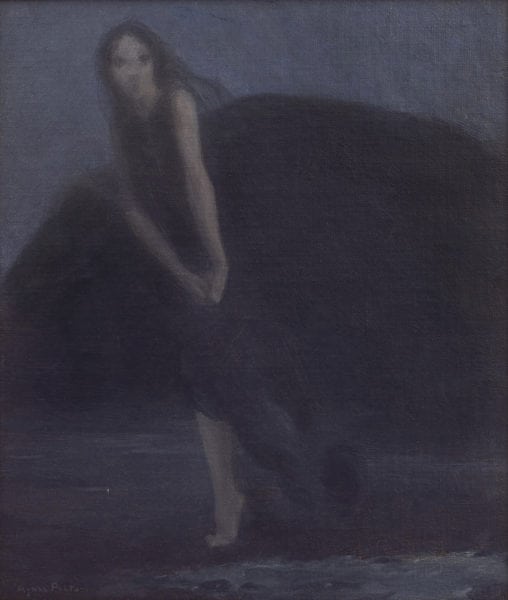Woman on the Beach, ca. 1910
Agnes PeltonOil on canvas
14 × 12 inches
Signed (lower left): Agnes Pelton.
Born into a family rocked by a sexual scandal involving her maternal grandmother, Elizabeth Tilton, and Henry Ward Beecher (the famous abolitionist clergyman), Agnes Pelton’s biography reads like a great Victorian novel. A sickly, but precocious child, she was educated largely at home by her mother who ran a music school in Brooklyn after Agnes’s father died when she was only nine years old. From the young age of fourteen she began studying with Arthur Wesley Dow, however in 1900 she fell almost fatally ill and gave up painting all together. Then, a trip to Paris in 1905 seems to have stirred something within her. By 1907 she was painting again.
Woman on the Beach was painted shortly after her return to making art. Working with a limited palette of blues, dark greens, grays, blacks and browns, Pelton created a mysterious figure emerging from the darkness. Standing on tiptoe by the side of a pool of water, the woman looks out at the viewer. Her hair and skirt billow behind her, further suggesting movement. A dark dune rises in the background. The moon, although it is nowhere to be seen, highlights her pale skin.
Pelton kept the details to a minimum. Rocks and water are among the most fully rendered, while the figure’s facial features are barely suggested and ghostlike. Yet the work is laden with atmosphere, moodiness and enigma, reflecting her interest in Romantic artists and writers and the poetically beautiful. In the years prior to 1910, Pelton’s work was focused on the effects of varied natural lighting on figures out-of-doors. Shortly thereafter, she began to refer to these figures in a landscape setting as her ‘Imaginative Paintings’. While some carry titles linking them to natural phenomena or specific psychological states, the meaning of Woman on the Beach, is intentionally vague. Pelton allows the viewer to project his own questions and stories onto this appealing and wistful young woman.

